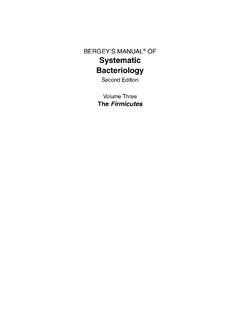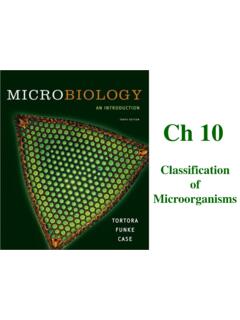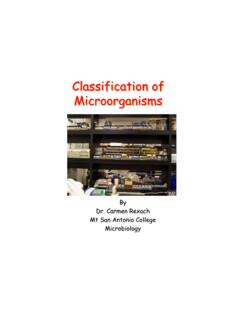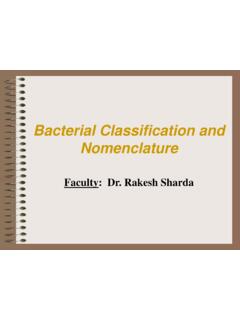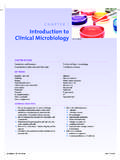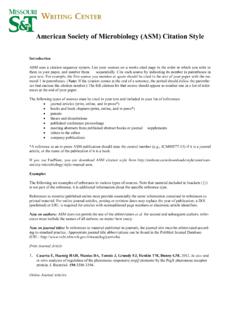Transcription of THE IDENTIFICATION OF BACTERIAL ISOLATES
1 THE IDENTIFICATION OF BACTERIAL ISOLATESWHAT IS MEANT BY IDENTIFICATION ?The taxonomy of bacteria (or of any other group of organisms) consists of three interrelated areas. The task of arranging organisms into related groups is called classification. Nomenclature refers to the assignment of names to these groups, guided by a set of rules. IDENTIFICATION is the process of determining to which established taxon a new isolate or unknown strain belongs. This last task is the area of taxonomy which the computer program, Identibacter interactus, RELATIONSHIP OF IDENTIFICATION TO BACTERIAL CLASSIFICATION AND order to identify an unknown BACTERIAL isolate, the characteristics of the isolate must be compared to known taxa. In microbiology, the basic taxonomic unit is the species, and groups of related species are placed in the same genus.
2 However, the term "species" does not have quite the same meaning in bacteriology as it does in the classification of plants and animals. In the latter cases, species are rigorously defined on the basis of individuals' capacity for interbreeding and geographical isolation. No such absolute tests are possible with asexual, globally-distributed BACTERIAL BACTERIAL species are defined operationally they are collections of similar strains. Classification schemes contain the criteria whereby the characteristics used to distinguish one species from other related ones are presented There is no "official" classification of bacteria, but reference sources such as Bergey's Manual of Determinative bacteriology and Bergey's Manual of systematic bacteriology are the most commonly used resources in IDENTIFICATION of unknown cultures is a practical application of a classification scheme, so that a new isolate can be recognized as a member of an existing IS THE IDENTIFICATION OF BACTERIAL UNKNOWNS IMPORTANT?
3 Microbiologists must identify BACTERIAL ISOLATES for several practical reasons: Medical diagnostics identifying a pathogen isolated from a patient. Food industry identifying a microbial contaminant responsible for food spoilage. Research setting identifying a new isolate which carries out an impor tant weakness of the classical classification scheme embodied in Bergey's Manual is that it is arbitrary; that is, it is weighted towards those characteristics that the community of microbiologists feel are most useful in distinguishing species. In addition, this classification scheme provides no insight into the evolutionary relationships among organisms, in the way that the Linnaean classification of plants and animals does. During the last decade, alternative means of characterizing bacteria have been developed based upon the chemical composition of the cells.
4 Two of the methods are: (a) analysis of the pattern of fatty acids found in BACTERIAL cell membranes, and (b) comparison of nucleic acid sequences. The analysis of 16s ribosomal RNA sequences has been especially useful in providing information about the evolutionary relationships among bacteria. See the bibliographic references for more BACTERIA ARE REPRESENTED AS UNKNOWNS IN THE SIMULATION?Bergey's Manual of Determinative bacteriology contains information on approximately 4000 BACTERIAL species. (Note that microbiologists believe the species known from cultures may represent only a few percent of all the BACTERIAL species present on earth). The computer simulation contains a database of about 60 BACTERIAL species. It is not representative of the breadth of species described in Bergey 's Manual, but rather represents a set of species commonly used in undergraduate microbiology laboratories, and in addition includes some BACTERIAL pathogens not usually assigned in introductory of the species in the simulation are true Bacteria that make a cell wall.
5 Therefore, neither Archaea nor mycoplasmas are represented. All of the species arc chemoheterotrophic. Neither photosynthetic or chemoautotrophic bacteria are included. In addition, virtually all of the included species will grow under aerobic conditions on typical enriched laboratory media (for example, nutrient agar). Thus, obligate anaerobes are generally not represented in the the list of the species used in Identibacter TESTS DO I HAVE AVAILABLE TO ME?A set of 52 tests can be accessed in the computer simulation. For a more complete description of the tests, consult a general microbiology text or lab INFORMATION ON THE CHARACTERISTICS OF THE ORGANISMS IS AVAILABLE?The computer simulation contains help on group and genus characteristics and information on a few organisms at the species level. Access these items from the HELP menu.
6 Information on the distinguishing characteristics of species in some groups is presented in Appendix C. You may also consult a more extensive reference source, such as Bergey's Manual of Determinative bacteriology to obtain STRATEGY OF IDENTIFICATIONA dapted from Cowan and Listen, "The Mechanism of IDENTIFICATION ", in the 8th edition of Bergey's Manual of Determinative DO I IDENTIFY AN UNKNOWN BACTERIUM?To distinguish broad categories, the oxygen requirement for growth is of special importance. Another important physiological characteristic to distinguish broad categories is whether the organism metabolizes carbohydrates ( , glucose) by fermentation, respiration, or both taxa are organized in groups. Each group is a cluster of genera. Your first task is to determine to which of these groups your unknown belongs.
7 The titles of the groups provide hints as to what characteristics are most useful in making this determination ( , "Facultatively anaerobic Gram-negative rods"). Thus, the true Bacteria are classified primarily on the basis of their morphology and and physiological tests can then be used to distinguish among genera within a group, and between species once you have identified the correct genus. The specific tests that are most useful will differ depending upon the group you are investigating, but tests which are frequently useful are the catalase, oxidase, urease, and deaminase/decarboxylase reactions, as well as tests for fermentation products and nitrate OF THE GAME1. Use all of the information available to you2. Work from broad categories down to smaller, specific Apply "common sense" at each Use the minimum number of tests to make the goal of this simulation is to provide the opportunity to solve a number of un-knowns.
8 This will give you the experience to develop "common sense" about the organization and logic of BACTERIAL STEPS TO FOLLOW1. Start with a pure culture. In the computer simulation this is a given, but in the laboratory one must be sure of this, because the reactions of mixed cultures are of no Examine a Gram stain of the cells in the light microscope. Examination by phase contrast microscopy may also indicate a unique morphological property (for example, endospores). NOTE: If unique morphological characteristics are present, confine your IDENTIFICATION to groups having these Examine gross growth appearance on agar medium for pigments or other unique Test the oxygen requirements for Test the mode of carbohydrate metabolism oxidative or Scan the characteristics of the genera to which your unknown may belong (based upon the data available from steps 2 - 5) to find specific tests that can distinguish between these IF I CANNOT IDENTIFY MY ORGANISM1.
9 In the real world, you would first check to see if you have a pure Review your interpretation of your test Have you correctly used the diagnostic tables online or in Bergey's Manual"!4. Are there other tests that can distinguish between the remaining possible genera or species?--adapted from Benson, H J, Microbial Applications, 7th ed, McGraw-Hill, 1998
